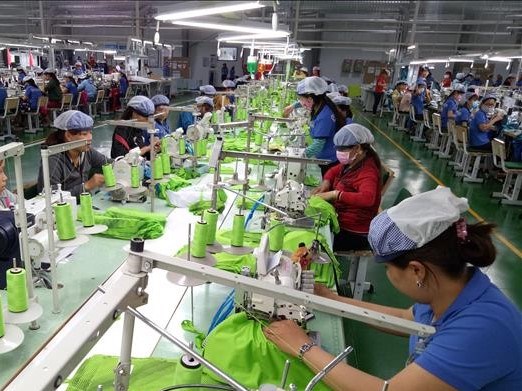FTAs to bring both opportunities and challenges: Minister
Joining new-generation free trade agreements (FTAs) will help Vietnam diversify its economic and trade relations, especially expanding import and export markets, avoiding excessive dependence on a specific region and helping the economy cope better with external fluctuations.
 A production line of Far Eastern New Apparel Vietnam Company in Bac Dong Phu Industrial Park in the southern province of Binh Phuoc (Photo: VNA)
A production line of Far Eastern New Apparel Vietnam Company in Bac Dong Phu Industrial Park in the southern province of Binh Phuoc (Photo: VNA)Hanoi (VNS/VNA) - Joining new-generation free trade agreements (FTAs) will help Vietnam diversify its economic and trade relations, especially expanding import and export markets, avoiding excessive dependence on a specific region and helping the economy cope better with external fluctuations.
The remark was made by Minister of Industry and Trade (MoIT) Tran Tuan Anh in an article sent to the Vietnam News Agency (VNA) recently.
Anh wrote in the article participating in FTAs will continue to promote trade between Vietnam and members of the Comprehensive and Progressive Agreement for Trans-Pacific Partnership (CPTPP) and EU countries, especially in areas of Vietnam’s strength. For members of the CPTPP, including major markets such as Japan and Canada, to cut import tax to zero percent for Vietnamese goods will have a positive effect on promoting export turnover.
“Tax on exports, such as agriculture, fishery, electricity and electronics will be eliminated when the agreement takes effect. A MoIT study shows that Vietnam’s exports are likely to increase by 4.04 percent by 2035,” Anh wrote.
According to a study by the World Bank, with this level of commitment, in the context of the basic economic conditions remaining unchanged, Vietnam’s exports may increase by 4.2 percent in the context of productivity growth, while export growth will be 6.9 percent by 2030, he said.
As for the EVFTA, the agreement between Vietnam and the EU will help the country’s exports increase by an average of 6.7 percent for the first five-year period of implementation, 13 percent for the next five years and 20 percent for the period five years later.
The minister said Vietnam’s exports currently account for nearly 1.5 percent of the total EU import turnover. Among them, only about 42 percent of Vietnam’s export turnover is entitled to a tax rate of zero percent (including goods under the GSP universal tariff incentive programme).
“This is a very modest figure compared to the export potential of Vietnam as well as the market size of the EU. With the commitment to cut taxes in the EVFTA and especially the strong complementary trade structure, the potential for the two sides to further develop economic-trade relations after the FTA is huge,” Anh said.
In addition, Vietnam also has opportunities to participate in regional and global supply chains. Currently, countries participating in CPTPP and EVFTA agreements account for 13.5 percent and 22 percent of global GDP, respectively.
According to the General Department of Customs, the total trade turnover between Vietnam and CPTPP countries reached more than 51 billion USD in the first eight months of 2019; while that between Vietnam and the EU reached about 38 billion USD by the end of November 2019.
With the scale of GDP and trade turnover, joining these FTAs will open up many opportunities for businesses when the new supply chain is formed, which is an important condition to raise the level of development of the economy, increase labour productivity, gradually reduce assembly, participate in higher value-added production stages, and then step into the development stage of electronics, hi-tech and green agricultural products.
“This is a great opportunity to improve Vietnam's economy in the next ten years,” Anh said.
Regarding opportunities for institutional reform, improving the business environment, as well as joining the former WTO and joining the new generation FTAs, will be an opportunity for Vietnam to continue improving its legal and business environment.
Along with the ratification of the CPTPP, the National Assembly also decided to amend some contents of the Intellectual Property Law and the Insurance Business Law as a testament to the policy of continuing to improve economic and legal institutions of the Party and the State.
At the same time, the extensive commitments in the service - investment sector will give Vietnam more opportunities to improve the business environment in a more open, transparent and predictable manner, close to national standards. In addition, the economy has advanced, thus promoting both domestic and foreign investment.
“Joining the new generation FTAs also supports the process of renewing the growth model and restructuring Vietnam’s economy, especially in areas such as finance – banking, public spending and agriculture,” Anh said.
The connection with partners, such as the EU, Japan and Canada also helps Vietnamese businesses connect with technology and management capacity at the most advanced level in the world. “This is an opportunity for Vietnamese businesses to learn and strive to meet the demands of the global competitive environment.”
According to research results from the Ministry of Planning and Investment, the CPTPP can help increase the total number of jobs by an average of 20,000 – 26,000 per year. As for poverty reduction, according to a World Bank study, by 2030, the CPTPP is expected to help 0.6 million poor people escape the poverty line of 5.5 USD per day. All income groups are expected to benefit.
However, international economic integration and participation in free trade agreements, especially the new generation agreements, not only bring about opportunities, but also risks and challenges.
“These are economic challenges on completing the legal and institutional framework, implementing commitments in new areas not yet included in previous FTAs such as labour and environmental unions,” Anh said.
“Therefore, in the near future, Vietnam needs to have effective solutions to implement and make good use of the opportunities in these FTAs. At the same time, we will continue to focus resources on promoting the ratification of the EVFTA in the shortest time in order to benefit the people and businesses of both sides soon,” he added./.
The remark was made by Minister of Industry and Trade (MoIT) Tran Tuan Anh in an article sent to the Vietnam News Agency (VNA) recently.
Anh wrote in the article participating in FTAs will continue to promote trade between Vietnam and members of the Comprehensive and Progressive Agreement for Trans-Pacific Partnership (CPTPP) and EU countries, especially in areas of Vietnam’s strength. For members of the CPTPP, including major markets such as Japan and Canada, to cut import tax to zero percent for Vietnamese goods will have a positive effect on promoting export turnover.
“Tax on exports, such as agriculture, fishery, electricity and electronics will be eliminated when the agreement takes effect. A MoIT study shows that Vietnam’s exports are likely to increase by 4.04 percent by 2035,” Anh wrote.
According to a study by the World Bank, with this level of commitment, in the context of the basic economic conditions remaining unchanged, Vietnam’s exports may increase by 4.2 percent in the context of productivity growth, while export growth will be 6.9 percent by 2030, he said.
As for the EVFTA, the agreement between Vietnam and the EU will help the country’s exports increase by an average of 6.7 percent for the first five-year period of implementation, 13 percent for the next five years and 20 percent for the period five years later.
The minister said Vietnam’s exports currently account for nearly 1.5 percent of the total EU import turnover. Among them, only about 42 percent of Vietnam’s export turnover is entitled to a tax rate of zero percent (including goods under the GSP universal tariff incentive programme).
“This is a very modest figure compared to the export potential of Vietnam as well as the market size of the EU. With the commitment to cut taxes in the EVFTA and especially the strong complementary trade structure, the potential for the two sides to further develop economic-trade relations after the FTA is huge,” Anh said.
In addition, Vietnam also has opportunities to participate in regional and global supply chains. Currently, countries participating in CPTPP and EVFTA agreements account for 13.5 percent and 22 percent of global GDP, respectively.
According to the General Department of Customs, the total trade turnover between Vietnam and CPTPP countries reached more than 51 billion USD in the first eight months of 2019; while that between Vietnam and the EU reached about 38 billion USD by the end of November 2019.
With the scale of GDP and trade turnover, joining these FTAs will open up many opportunities for businesses when the new supply chain is formed, which is an important condition to raise the level of development of the economy, increase labour productivity, gradually reduce assembly, participate in higher value-added production stages, and then step into the development stage of electronics, hi-tech and green agricultural products.
“This is a great opportunity to improve Vietnam's economy in the next ten years,” Anh said.
Regarding opportunities for institutional reform, improving the business environment, as well as joining the former WTO and joining the new generation FTAs, will be an opportunity for Vietnam to continue improving its legal and business environment.
Along with the ratification of the CPTPP, the National Assembly also decided to amend some contents of the Intellectual Property Law and the Insurance Business Law as a testament to the policy of continuing to improve economic and legal institutions of the Party and the State.
At the same time, the extensive commitments in the service - investment sector will give Vietnam more opportunities to improve the business environment in a more open, transparent and predictable manner, close to national standards. In addition, the economy has advanced, thus promoting both domestic and foreign investment.
“Joining the new generation FTAs also supports the process of renewing the growth model and restructuring Vietnam’s economy, especially in areas such as finance – banking, public spending and agriculture,” Anh said.
The connection with partners, such as the EU, Japan and Canada also helps Vietnamese businesses connect with technology and management capacity at the most advanced level in the world. “This is an opportunity for Vietnamese businesses to learn and strive to meet the demands of the global competitive environment.”
According to research results from the Ministry of Planning and Investment, the CPTPP can help increase the total number of jobs by an average of 20,000 – 26,000 per year. As for poverty reduction, according to a World Bank study, by 2030, the CPTPP is expected to help 0.6 million poor people escape the poverty line of 5.5 USD per day. All income groups are expected to benefit.
However, international economic integration and participation in free trade agreements, especially the new generation agreements, not only bring about opportunities, but also risks and challenges.
“These are economic challenges on completing the legal and institutional framework, implementing commitments in new areas not yet included in previous FTAs such as labour and environmental unions,” Anh said.
“Therefore, in the near future, Vietnam needs to have effective solutions to implement and make good use of the opportunities in these FTAs. At the same time, we will continue to focus resources on promoting the ratification of the EVFTA in the shortest time in order to benefit the people and businesses of both sides soon,” he added./.













